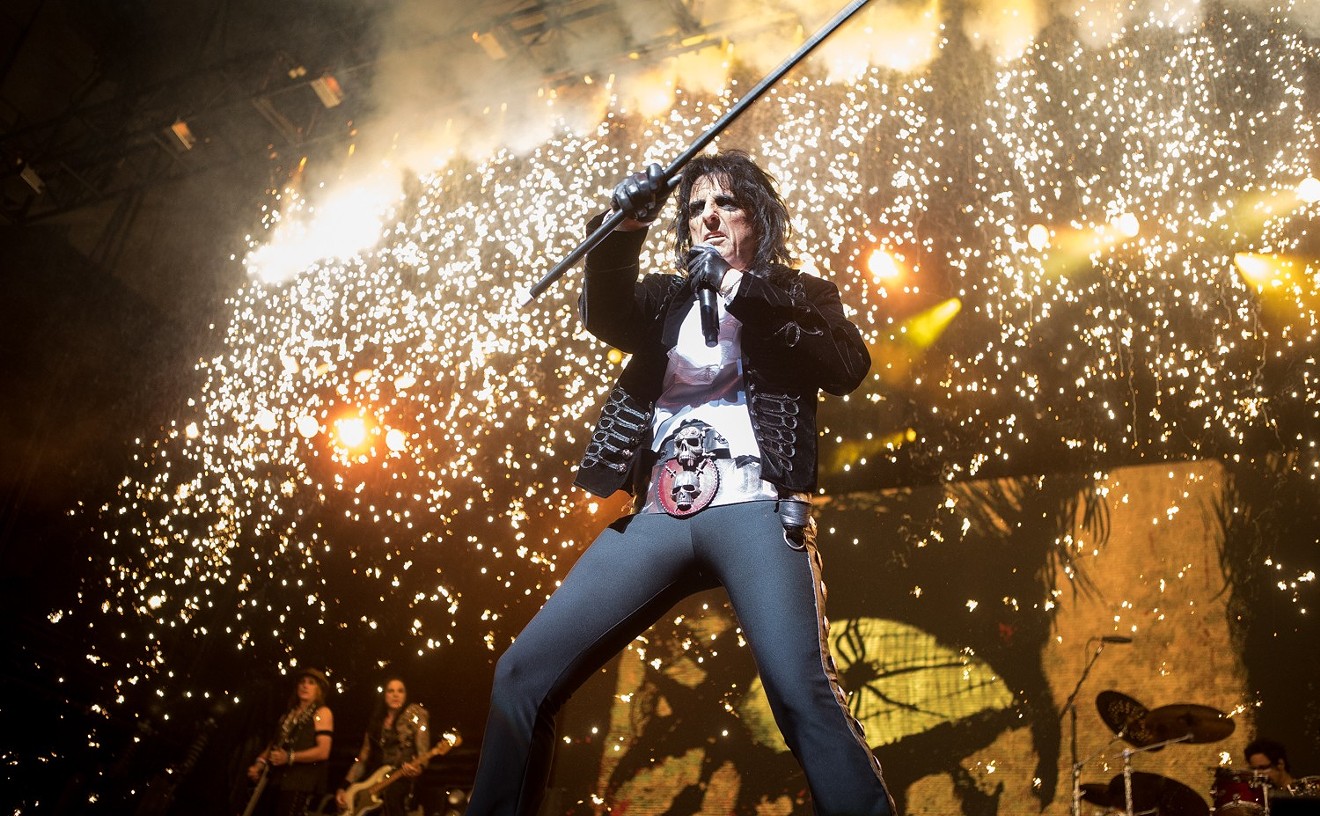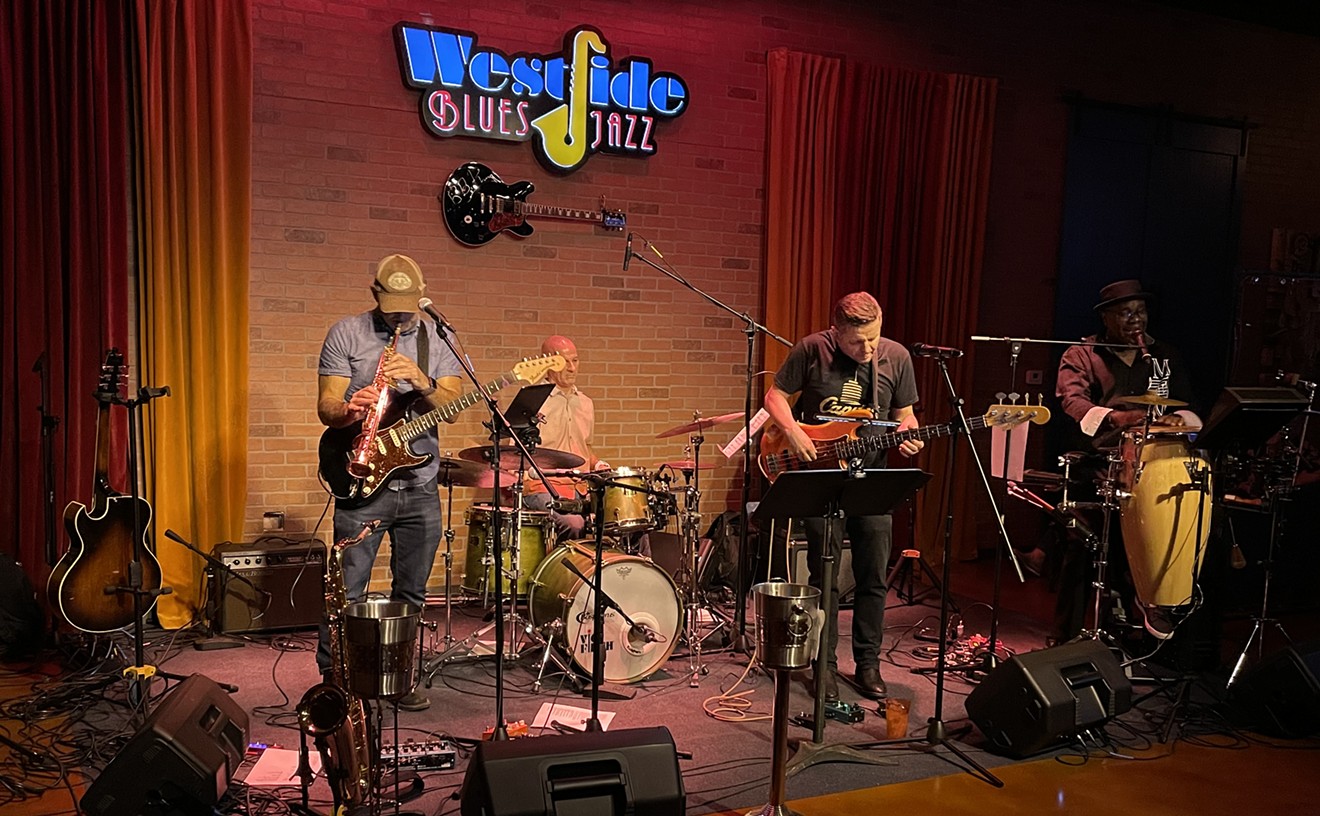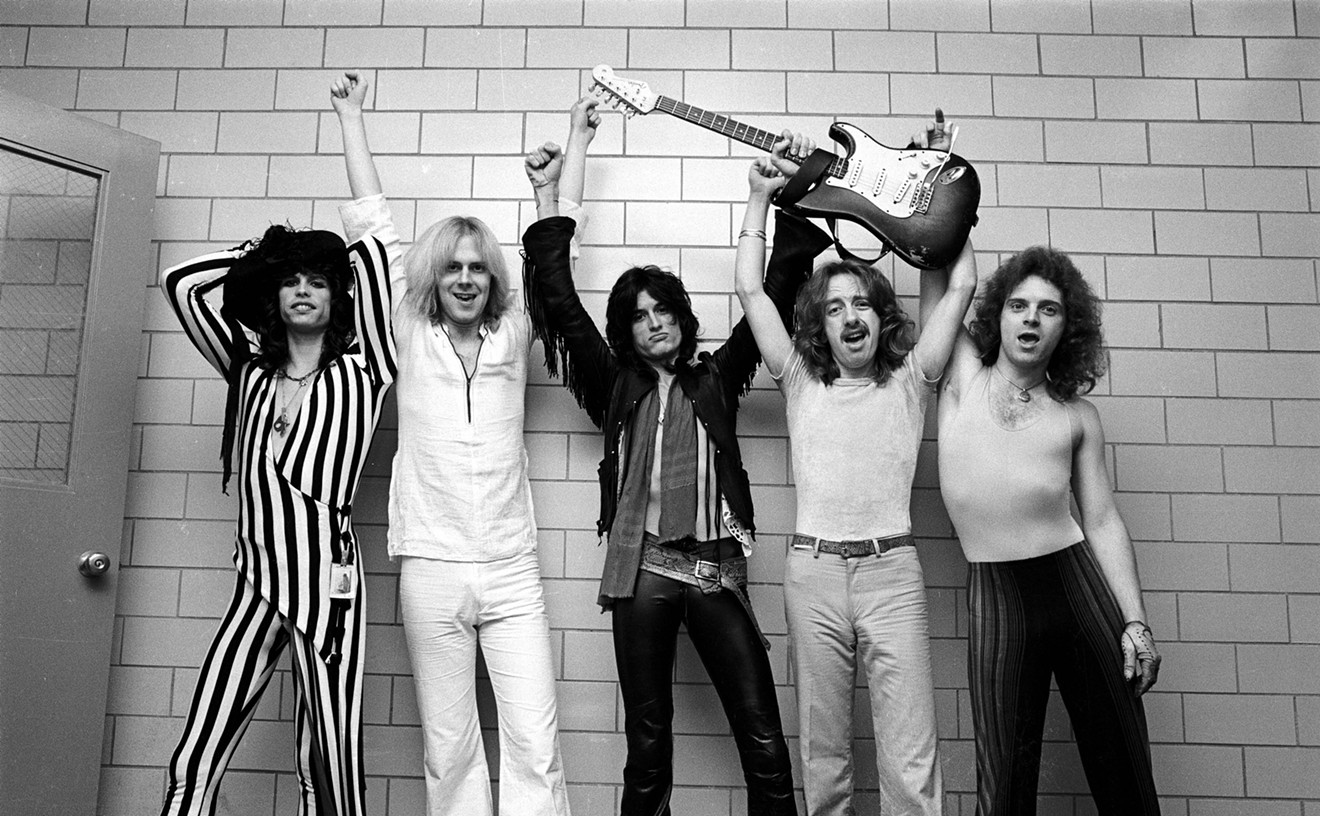Stephanie Carrico knows what it's like to be an underdog, an outsider, the one who was picked on in her youth.
The 38-year-old Trunk Space co-owner remembers not having a place as a teenager where like-minded misfits could hang, could exert their nascent creativity in an atmosphere where conventional notions of art and community took a backseat to individuality and a true do-it-yourself spirit.
Basically, a place where, as Carrico puts it, one goes to fail — and gets better because of it.
For a decade, Phoenix's experimental musicians and artists have been failing — and, yes, getting better because of it — at the Trunk Space, ground zero for the Valley's all-ages rock scene, tour stop for countless under-the-radar bands needing a place to play between Los Angeles and anywhere east of Phoenix, visual art gallery, a pioneer in Grand Avenue's revitalization, and as vital a player in Phoenix's underground culture as there is.
Carrico and co-owner Jason Nosaj (a.k.a. JRC) turned a moribund storefront on a go-nowhere stretch of Grand Ave into a countercultural hub and haven for under-21 rock fans who can't yet catch live music in the nightclub scene.
Now, 10 years on, Trunk Space is celebrating with Indie 500, a 10-day festival featuring five bands each night performing 10 songs apiece. In conjunction with Indie 500 is a group art exhibit opening Friday, April 4 (the official 10-year anniversary), and aptly titled "You're Always Welcome Here."
On the occasion of Trunk Space's milestone, we're letting some of those who've navigated the Trunk Space universe since its early days tell the story. (Interviews have been condensed or edited for clarity.)
Andrew Jemsek (Fathers Day/Freaks of Nature/countless other bands): I started going to the Trunk Space in 2004. Ryan Avery booked my band, Haunted Cologne. Ryan hit us up one day and said, "There's this place called the Trunk Space. You should really play there. We should do stuff there." So we did. To this day, JRC and Steph are very open. Their attitude is: You can do anything in this place.
Ben Gallaty (Andrew Jackson Jihad): The cool thing about Trunk Space is, first off, that they were willing to book Andrew Jackson Jihad. The first show that we played back in 2004, there were maybe a dozen people — probably less, though — and they were willing to book the show, which I thought was great because, at another venue, if there weren't like 50 people at the show, then you could count on them never booking you again because they're not making a bunch of money off of you.
Abe Gil (Treasure Mammal): Crazy experiences are part of what makes up the longevity of Trunk Space. First, the venue was cleaned up and made into a place for local and touring acts to perform. Fixed up by a couple with their own passions for expression and DIY culture. Their will has fostered the entire thing, because as they have said, they make no money in running this venue.
In fact, for Carrico, originally from Utah, and 40-year-old Nosaj, a native of Buffalo, New York, the Trunk Space fits the very definition of "labor of love," especially in the venue's early years.
Steph Carrico (co-owner): There was a night, probably in 2007, when things were overwhelming here and I thought if Trunk Space is supposed to go on, someone will pay with a dollar coin. A few minutes later, a guy paid his entire $5 cover charge with silver dollars. Then, I was, like, all right, universe, thanks for that! About a half an hour later, [local musician] Stephen Steinbrink walked up to me with a silver dollar — and I hadn't even said this out loud to anyone. He handed it to me and said, "I think I'm supposed to give this to you. I really want you to have this." I had to walk away because I started to cry. Whatever powers that be were saying, "No, you gotta keep doing this. No bailing now." I carry the silver dollar with me to this day from Stephen.
Alex Votichenko (a.k.a. Djentrification): Trunk Space could not exist unless people really loved music there. Trunk Space is proof that there's a real scene in Phoenix; people who really love music. It wouldn't be around as long if it hadn't.
Beatrice Moore (landlord/entrepreneur/ Grand Ave revivalist): JRC and Steph are certainly very dedicated to what they're doing. They have a niche with a lot of the indie bands that play there. They are one of the few spaces that encourage a younger audience, but it's not just young people; it's different ages, which is really interesting. They should be given credit for nurturing that young audience and for providing a space for them to go to hang out.
They also have a really good symbiotic relationship with the Bikini Lounge, which had a dying audience when we first bought it. It was mostly old people, and a lot of them had died off, and it was a very small group of people that were going there. It was because of the art communities from First Friday, the Art Walk, and Trunk Space that Bikini Lounge got really revived.
The music has always come first at the little storefront at 1506 Grand Avenue, and the Trunk Space's reputation precedes itself.
It has become known as one of the best DIY venues in the country, hosting thousands of the type of band that often winds up performing for gas money, sleeping on local bands' couches, and essentially getting by on T-shirt sales at gigs.
Carrico and JRC estimate that 9,000 bands have taken the tiny triangular stage at Trunk Space, many of them performing there on their way to achieving varying degrees of mainstream success, including Titus Andronicus, Screaming Females, and Ghost Mice.
Emily Spetrino-Murtagh (owner of Bragg's Factory Diner): My husband, Liam, and I ran a little candy and record shop right next door to Trunk Space in 2009 called Sweets and Beats. Joe Jack from The Dead Milkmen was doing a solo show there, which was a huge deal for JRC, and I remember we had the shop open that night, so we weren't able to pop in to see him play. We closed up and were headed to bed (we were living in the back half of the shop) and as we were laying down, Joe Jack was finishing his set with "Punk Rock Girl," and I just thought to myself, what a totally rad thing to experience, being put to bed with The Dead Milkmen singing to you.
Phil Buckman (I Hate You When You're Pregnant): The tight quarters of the Trunk Space really gives a sense of intimacy between performers and audiences, which blurs the line between the two. Venues can have a high-set stage and dance floor, and it honestly feels like some sort of forced segregation. Trunk Space makes it feel like a party, void of writ roles.
Teague Cullen (Foot Ox): Young artists often have little to no encouragement from their families, school, and sometimes even their friends. I saw so many people play their first shows at the Trunk Space, after which they would be glowing. And you could see their soul finally had expressed something that could not have been said with regular language. My favorite shows at the Trunk Space had 20 to 30 people, everyone knew each other or would by the night's end, with no one acting like rock stars. Just kids excited to be given a chance to do whatever they needed to and to express how strange it is to be a human.
Jason Nosaj (a.k.a. JRC, co-owner of Trunk Space): Spiritually, we think of the Trunk Space as a vaudeville house, which is part of the aesthetic of wanting to keep our events affordable. You could go to a vaudeville show and you'd see 12 acts, plus a movie, for a nickel. It's the idea of having infinite variety that your specialty is not going to be the same as anybody else's.
The venue has cemented itself as proving ground for numerous local musicians, many of whom likely played their first notes in public at the Trunk Space and many more who take an unconventional approach to rock music.
Ryan Avery (Hi My Name Is Ryan/Fathers Day): The first time I went to the Trunk Space was in 2004, only, like, a month or two after it opened. I had a really weird vibe because the only people who booked shows there were promotional groups that I wasn't really friendly with. There was a completely different scene or culture that was "claiming" the Trunk Space as their own. It wasn't until sometime in 2005 that it felt like the Trunk Space was focusing more on weirder art and performances.
Aaron Johnson (owner of Lawn Gnome Publishing): The coolest thing about Trunk Space has been how it has always, from the beginning, incorporated performance art with music. I remember at one show, Treasure Mammal turned the entire floor into a Ouija board and had a camera up above filming the whole thing and projecting it. They grabbed one of the members of the band by the legs like a wheelbarrow — he was the Ouija board piece, and the audience moved him around to do a séance.
Avery: At the "Real Coachella" [local music festival] in 2011, Andy Hiller and Jeremy Finch performed as the Scissor Sisters. They wore white robes, painted their faces white, and they set up on the stage outside playing this really low, droney noise music, but no one knew what they had prepared at all because everyone was inside watching the other band. All of a sudden, there are candles lit outside and this scary demonic music playing, and all these men in white robes with their faces painted white. I remember Steph and JRC were so freaked out because their neighbor from the junkyard behind them was, at that point, calling the city and saying that they were doing devil worship. It did look really demonic, but Andy and Jeremy had no idea that was going on.
Jason Anderson (singer-songwriter): A few years ago, Trunk Space was shut down for renovations. JRC and Steph temporarily moved all shows to the parking lot, where bands would perform in the back of a red Toyota pickup. The venue was rechristened "Truck Space," and whether it was the sheer novelty or the fact that the music sounded pretty great outdoors and under the stars, the "new" spot actually got quite a bit of local press, with a few writers even going so far as to dub Truck Space "Phoenix's hottest new venue."
Anyone who's attended a Trunk Space show during the summer knows it literally can be Phoenix's hottest venue.
Carrico and Nosaj realized something had to be done one midsummer night when they felt accomplishment and defeat in equal measure. They had booked New Orleans-based one-man band Quintron and successfully filled their venue with fans. Known for giving sweat-soaked performances, Quintron finished his first set, staggered through the crowd and out the door, puking in exhaustion in front of the venue. He staggered back in for an encore before his gastrointestinal system gave a repeat performance all over the sidewalk.
Earlier this year, Carrico and Nosaj went to the Internet to crowdfund the purchase and installation of an air conditioner, seeking $15,000 on crowdfunding site IndieGoGo.com.
Nosaj: The truth is that in Phoenix, air-conditioning is not a convenience; it really is a necessity. With A/C, we can have more events; we can be more welcoming to people who come from out of town. We can be here longer hours. We can do more with this. We can double what we do.
Carrico: There's some performance art stuff that we have sent away, like some burlesque troupes. Punk kids will rock out in the heat, but a bunch of adults don't want to sit here when it's 98 degrees and watch a burlesque show. There's stuff we've had to turn away in the summer just because it is too hot.
The installation of an air-conditioning unit positions the scrappy Trunk Space for a long run into the next decade.
Carrico: I want to see Trunk Space still here in another 10 years. I want to see Trunk Space go to 20 years, and I'd love for it to turn 21. I'd like to see more people involved, so I don't have to be here every night, and I don't have to run to Smart and Final, and JRC doesn't have to book every show. I would love to share the responsibility even more with people and be the head of a collective
Nosaj: If we close tomorrow, there are no regrets over anything that we did.
Carrico: Absolutely not. This has been the most amazing experience I could ever ask for.
Nosaj: I want to be part of a legacy, not an end point. That's why when we talked about vaudeville, we're vaudeville and vaudeville does not end. When Earth is burned to a cinder and we're living on spaceships, there will be people getting together to make art, to show art, to talk about it, to have performances — and that's what we want. I just want to be another link in the chain.










